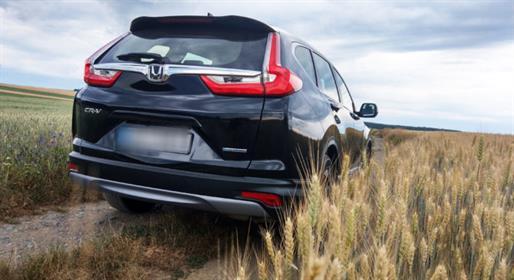We are testing the new fifth generation Honda CR-V in our editorial office for the fourth time. We originally tested this car with a classic turbocharged petrol fifteen-cylinder, which alternatively took care of driving one or both axles. Subsequently, a new hybrid came on the market and we got our hands on it first with all-wheel drive and now with only front-axle drive.

Honda CR-V hybrid
The current fifth generation has completely disdained diesel units and relies only on a gasoline turbocharged "fifteen" and on a technologically completely new hybrid. And that one, with only front axle drive, became my companion for the past week.
Compared to its competitors, the hybrid powertrain in the new fifth generation Honda CR-V stands out for its tremendous silence. I'm not a long-term expert on hybrid cars, but the new CR-V hybrid is the quietest car I've driven so far.
Simply put, the hybrid presented by Honda is equipped with a 2.0-liter i-VTEC gasoline engine with an Atkinson cycle that offers a power of 107 kW (145 hp) at 6200 rpm, and then a powerful electric motor with a power of 135 kW (184 k) with a torque of 315 Nm. The car is also equipped with a lithium-ion battery and a gearbox with a constant gear ratio.
Honda's i-MMD technology intelligently and automatically switches between three drive modes to ensure the highest possible operating efficiency. These modes are: electric drive , where the lithium-ion battery directly powers the drive electric motor; hybrid drive , where the gasoline engine supplies energy to the generator, which in turn supplies it to the drive electric motor; and engine drive , where the clutch locking mechanism creates a direct connection between the gasoline engine and the wheels.

In urban traffic, to ensure optimum efficiency, the Honda CR-V Hybrid switches between hybrid and electric drive in most situations. In the hybrid drive mode, excess energy from the gasoline engine can be diverted back through the generator and used to charge the battery. The electric drive mode enables an electric power source and thanks to it, the CR-V has an emission-free range of about 2 km, depending on the driving situation and battery charge. The motor drive mode (i.e. a direct connection between the gasoline engine and the wheels) represents the most efficient solution for driving at higher speeds, and if necessary, the engine speed can be increased using the drive electric motor and thus boost the performance in certain conditions. Here, unfortunately, you will experience, for me, a rather uncomfortable feeling, when the sound of the engine itself is not adequate for the speed you are currently driving. For me, that's probably the only negative I can see about this hybrid device, which luckily doesn't come up that often.
The new hybrid system does not use a classic gearbox, instead only a constant gear ratio ensures a direct connection of moving parts, which makes the torque transfer smoother. In the interior, instead of the classic gearbox selector, there are only buttons for driving forward, neutral and parking. The reverse has a different controller that requires pulling out. There is also a sport mode or the function of invoking a purely electric drive.
The car is also equipped with a deceleration system using paddles under the steering wheel, which you can use to set a certain intensity of the car's deceleration.
With the hybrid powertrain, the Honda CR-V accelerates from zero to 100 km/h with front-wheel drive only in 8.8 seconds, and in the all-wheel-drive version in 9.2 seconds. The maximum speed of the hybrid model is then 180 km/h. On the consumption side, with the hybrid CR-V I was in a range of very pleasant values, from 5.5 to 6.1 l/100km.
This hybrid drive concept is one of the main ingredients, guaranteeing the silence and comfort that prevails when driving the car. A well-tuned chassis and steering contribute to a comfortable experience. In terms of chassis, the fifth generation works with a multi-element axle at the back, and at the front with a classic McPherson. As a result, the chassis is very comfortable, yet also very secure with a sharper driving style.

Time-tested exterior appearance
The fifth generation builds on the time-tested external appearance, which has undergone completely positive retouches. The CR-V does a very good job of deceiving the body, and as a result, it doesn't look as big as it really is. As for the front part, here I would highlight its sandwich arrangement, the very loading of the mask part, headlights and the entire hood on the bumper and front edges, fenders of the car. This detail greatly lightens the car, and yet gives it a clearly visible robustness. The rear part is then dominated by new horizontally and vertically oriented lamps. The horizontal proportion prevails here and again supports the robustness of the entire car. Yes, even in the second lowest Elegance trim, the fifth generation Honda CR-V can be a very presentable and handsome car.

Really spacious interior
The fifth-generation CR-V offers a richly dimensioned interior space. In the rear seats, you will experience truly unprecedented spaciousness, and not only in the legroom. Another positive of this part of the car is the quite traditional possibility of opening the side doors almost at a right angle for cars of this brand. The seats are generously dimensioned, when the backrests are folded down, the seats themselves easily move more towards the floor, improving the flatness of the storage area of the luggage compartment. It has a basic volume of 497 litres, after folding down the backrests subsequently 1694 litres. The loading edge is then, for the given segment, set low to the user's liking.
In the front part of the interior, we received light retouches as part of the fifth generation. The dashboard of the tested car, quite traditionally for today, is dominated by a seven-inch touchscreen infotainment display. It is quite nicely integrated together with the air conditioning selectors into one curved "plate"¨ that does not protrude from the dashboard in any way. As far as the infotainment controls are concerned, Honda traditionally has a somewhat more complicated environment that requires a bit of getting used to. The instrument panel in front of the driver is then fully digital, with a display providing information on the fuel level, battery charge status or a digital speedometer, as well as switchable information on consumption, radio, navigation, etc.
The fully multifunctional steering wheel also fits nicely. Unfortunately, I would attribute the operation of the individual controls to its dark side, mainly the controls for the radio volume itself.
As a result, the impression of the interior of the fifth generation Honda CR-V is definitely positive, it deserves praise mainly for its tremendous spaciousness and good workmanship.

In conclusion
The base price of the CR-V model with a weaker 1.5 VTEC TURBO gasoline engine (127 kW) with a six-speed manual transmission, 2WD drive and Comfort equipment starts at CZK 669,900 including VAT. But let's focus on the tested hybrid, you can buy it from the amount of 769,900 CZK including VAT, it is a hybrid with the basic Comfort equipment and with only front axle drive. You can then purchase a hybrid four-wheeler from CZK 899,900 including VAT, here with the Elegance equipment.
The fifth generation Honda CR-V is a car that offers quite a dynamic and robust exterior appearance. Undoubtedly, the positives of the Honda CR-V include its large interior space, comfortable and quiet chassis, precise steering and, now, also a very quiet hybrid powertrain. The hybrid drive takes this already good car up a considerable notch.

























